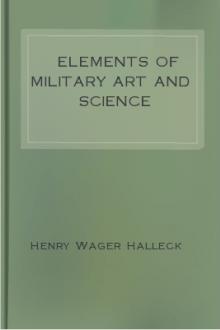Elements of Military Art and Science by Henry Wager Halleck (books you have to read txt) 📕

- Author: Henry Wager Halleck
- Performer: -
Book online «Elements of Military Art and Science by Henry Wager Halleck (books you have to read txt) 📕». Author Henry Wager Halleck
The true solution of the question is, then, not so much the amount of injury done on the one side or the other—particularly as there was on one side a city to suffer as well as the batteries—as the relative efficiency of the parties when the battle closed. All political agitation and popular clamor aside, what would have been the result had the fight been continued, or even had Lord Exmouth renewed it next morning? These are questions that can be answered only on conjecture; but the manner the battle ended certainly leaves room for many doubts whether, had the subsequent demands of Lord Exmouth been rejected, he had it in his power to enforce them by his ships; whether, indeed, if he had renewed the fight, he would not have been signally defeated. On the whole, we do not think that this battle, although it stands pre-eminent as an example of naval success over batteries, presents an argument to shake the confidence which fortifications, well situated, well planned, and well fought, deserve, as the defences of a seaboard.
We cannot help regarding these conclusions as just, when we reflect upon all the circumstances of the case. The high character, skill, and bravery of the attacking force; their immense superiority in number of guns, with no surplus human life to be exposed; the antiquated and ill-managed works of defence, the entire want of skill of the Algerine artillerists, and the neglect of the ordinary means of preparation; the severe execution which these ill-served guns did upon the enemy's ships,—an execution far more dreadful than that effected by the French or Dutch fleets in their best-contested naval battles with the ships of the same foe,—from these facts, we must think that those who are so ready to draw from this case conclusions unfavorable to the use of land-batteries as a means of defence against shipping, know but little of the nature of the contest.
An English historian of some note, in speaking of this attack, says:—"It is but little to the purpose, unless to prove what may be accomplished by fleets against towns exactly so circumstanced, placed, and governed. Algiers is situated on an amphitheatre of hills, sloping down towards the sea, and presenting therefore the fairest mark to the fire of hostile ships. But where is the capital exactly so situated that we are ever likely to attack? And as to the destruction of a few second-rate towns, even when practicable, it is a mean, unworthy species of warfare, by which nothing was ever gained. The severe loss sustained before Algiers must also be taken into account, because it was inflicted by mere Algerine artillery, and was much inferior to what may be expected from a contest maintained against batteries manned with soldiers instructed by officers of skill and science, not only in working the guns, but in the endless duty of detail necessary for keeping the whole of an artillery material in a proper state of formidable efficiency."
San Juan d'Ulloa.—The following facts, relative to the attack on San Juan d'Ulloa by the French, in 1838, are drawn principally from the report of a French engineer officer who was one of the expedition.
The French fleet consisted of four ships, carrying one hundred and eighty-eight guns, two armed steamboats, and two bomb-ketches with four large mortars. The whole number of guns, of whatever description, found in the fort was one hundred and eighty-seven; a large portion of these, however, were for land defence. (Fig. 37.)
When the French vessels were towed into the position selected for the attack, "it was lucky for us," says the French officer in his report, "that the Mexicans did not disturb this operation, which lasted nearly two hours, and that they permitted us to commence the fire." "We were exposed to the fire of one twenty-four-pounder, five sixteen-pounders, seven twelve-pounders, one eight-pounder, and five eighteen-pounder carronades—in all nineteen pieces only." If these be converted into equivalent twenty-four-pounders, in proportion to the weight of the balls, the whole nineteen guns will be less than twelve twenty-four pounders. This estimate is much too great, for it allows three eight-pounders to be equal to one twenty-four-pounder, and each of the eighteen-pounder carronades to be three quarters the power of a long twenty-four-pounder; whereas, at the distance at which the parties were engaged, these small pieces were nearly harmless. Two of the powder magazines, from not being bomb-proof, were blown up during the engagement, by which three of the nineteen guns on the water front of the castle were dismounted; thus reducing the land force to an equivalent of ten twenty-four-pounders. The other sixteen guns were still effective when abandoned by the Mexicans. The cannonade and bombardment continued about six hours, eight thousand two hundred and fifty shot and shells being fired at the fort by the French. The principal injury received by the work was from the explosion of the powder magazine. But very few guns were dismounted by the fire of the French ships, and only three of these on the water front. The details of the condition of the ships and fort are given in the report of the French officer,[22] but it is unnecessary to repeat them here.
[22]
Vide also House Doc. No. 206, twenty-sixth Congress, first session
In general terms, it appears from the above-mentioned report, that the number of guns actually brought into action by the floating force, (counting only one broadside of the ship,) amounted to ninety-four guns, besides four heavy sea-mortars; that the whole number so employed in the fort was only nineteen, including the smallest calibres; that these guns were generally so small and inefficient, that their balls would not enter the sides of the ordinary attacking frigates; the principal injury sustained by the castle was produced by the explosion of powder magazines injudiciously placed and improperly secured; that the castle, though built of poor materials, was but slightly injured by the French fire; that the Mexicans proved themselves ignorant of the ordinary means of defence, and abandoned their works when only a few of their guns had been dismounted; that notwithstanding all the circumstances in favor of the French, their killed and wounded, in proportion to the guns acting against them, was upwards of four times as great as the loss of the English at the battle of Trafalgar!
St. Jean d'Acre.—The narratives of the day contained most exaggerated accounts of the English attack on St. Jean d'Acre; now, however, the principal facts connected with this attack are fully authenticated. For the amount of the fleet we quote from the British official papers, and for that of the fort, from the pamphlet of Lieutenant-colonel Matuszewiez. These statements are mainly confirmed by the narratives, more recently published, of several English and French eye-witnesses.
The fortifications were built of poor materials, antiquated in their plans, and much decayed. Their entire armament amounted to only two hundred guns, some of which were merely field-pieces. The water fronts were armed with one hundred cannon and sixteen mortars, those of the smaller calibre included. (Fig. 38.) When approached by the British fleet, the works were undergoing repairs, and, says Commodore Napier, "were fast getting into a state of preparation against attack."
The British fleet consisted of eight ships of the line, carrying six hundred and forty-six guns; six frigates, carrying two hundred and thirty-six guns; four steamers, carrying eighteen guns; and two or three other vessels, whose force is not given. "Only a few guns," says Napier, "defended the approach from the northward," and most of the ships came in from that direction. The western front was armed with about forty cannon; but opposed to this were six ships and two steamers, carrying about five hundred guns. Their fire was tremendous during the engagement, but no breach was made in the walls. The south front was armed in part by heavy artillery and in part by field-pieces. This front was attacked by six ships and two steamers, carrying over two hundred guns. The eastern front was armed only with light artillery; against this was concentrated the remainder of the fleet, carrying about two hundred and forty guns. The guns of the works were so poorly mounted, that but few could be used at all; and these, on account of the construction of the fort, could not reach the ships, though anchored close by the walls. "Only five of their guns," says Napier, "placed in a flanking battery, were well served, and never missed; but they were pointed too high, and damaged our spars and rigging only." The stone was of so poor a quality, says the narrative of Colonel Matuszewiez, that the walls fired upon presented on the exterior a shattered appearance, but they were nowhere seriously injured. In the words of Napier, "they were not breached, and a determined enemy might have remained secure under the breastworks, or in the numerous casemates, without suffering much loss." The accidental explosion of a magazine within the fort, containing six thousand casks of powder, laid in ruins a space of sixty thousand square yards, opened a large breach in the walls of the fortifications, partially destroyed the prisons, and killed and wounded a thousand men of the garrison. This frightful disaster, says the French account, hastened the triumph of the fleet. The prisoners and malefactors, thus released from confinement, rushed upon the garrison at the same time with the mountaineers, who had besieged the place on the land side. The uselessness of the artillery, the breaches of the fort, the attacks of the English, all combined to force the retreat of the garrison, "in the midst of scenes of blood and atrocious murders."
We will close this account with the following extract of a speech of the Duke of Wellington, in the House of Lords, Feb. 4, 1841: "He had had," he said, "a little experience in services of this nature; and he thought it his duty to warn their lordships, on this occasion, that they must not always expect that ships, however well commanded, or however gallant their seamen might be, were capable of commonly engaging successfully with stone walls. He had no recollection, in all his experience, except the recent instance on the coast of Syria, of any fort being taken by ships, excepting two or three years ago, when the fort of San Juan d'Ulloa was captured by the French fleet. This was, he thought, the single instance that he recollected, though he believed that something of the sort had occurred at the siege of Havana, in 1763. The present achievement he considered one of the greatest of modern times. This was his opinion, and he gave the highest credit to those who had performed such a service. It was, altogether, a most skilful proceeding. He was greatly surprised at the small number of men that was lost on board the fleet; and, on inquiring how it happened, he discovered that it was because the vessels were moored within one-third of the ordinary distance. The guns of the fortress were intended to strike objects at a greater distance; and the consequence was, that the shot went over the ships that were anchored at one-third the usual distance. By that means, they sustained not more than one-tenth of the loss which they would otherwise have experienced. Not less than five hundred pieces of ordnance were directed against the walls, and the precision with which the fire was kept up, the position of the vessels, and, lastly, the blowing up of the large magazine—all aided in achieving this great victory in so short a time. He had thought it right to say thus much, because he wished to warn the public against supposing that such deeds as this could be effected every day. He would repeat that this was a singular instance, in the achievement of which undoubtedly great skill was manifested, but which was also connected with peculiar circumstances, which





Comments (0)